Peperomia Plant Care Guide + Popular Varieties

Peperomia is not an average houseplant with minimum care as its main advantage. Peperomia plant genus offers a complete collection of species with eye-catching foliage and incredible tolerance that can be planted in every season.
Originally from Mexico, South America, and the Caribbean, this genus of tropical plants showcases varieties in all shapes and colors. Peperomia types have thick, leather-like leaves that can be textured or smooth, large; small, or heart-shaped; and red, green, grey, purple; variegated, marbled, or solid.
Let us find out more about its characteristics, as well as peperomia care, propagation, and common problems that can affect this beautiful plant.
Peperomia Plant Info
Similar to its many appearances, the lovely peperomia is known by different names! including baby rubber plant, pepper elder, shining bush plant, and emerald ripper pepper too. The term radiator plants refer to this genus as well.
As a perennial from the Piperaceae family, the peperomia plant thrives in the moist but well-drained soil of its natural habitat in full or partial sun. In addition to its ornamental leaves, different types of peperomia also bloom in summer. However, these white, green, or brown flowers, which resemble offshoots, are not as nearly impressive as the variegated peperomia leaves.
This plant has a reasonable size which usually remains under 12 inches in both height and width. A feature that makes it perfect for growing indoors or on balconies. Other succulent-like characteristics of radiator plants include sturdy stems with many fleshy leaves.
It is good to know that the plants in this genus are not exactly succulents, whereas they exhibit varying degrees of succulence. Meaning they have certain adaptations that allow them to store water, tolerate infrequent watering, or arid conditions.
Peperomia Plant Benefits
Regardless of their foliage, all peperomia varieties purify the air, according to NASA research. Studies show that this species reduces the formaldehyde level indoors by 47 percent, which is considered one of its benefits as this substance makes up a significant portion of indoor air. Some varieties have medicinal uses as well.
And since they are entirely safe for adults, children, and pets from contact or ingestion, you can safely place peperomia plants anywhere in your home.
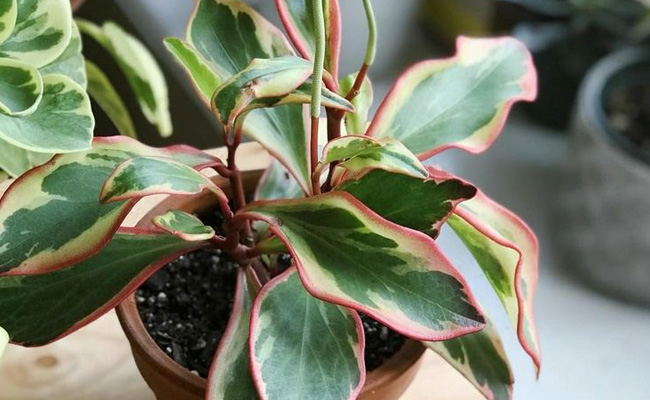
Peperomia Types
Before talking about peperomia care, let us get to know some of its popular varieties that are recommended to grow better:
Peperomia Marble (P. obtusifolia ‘Marble’)
As you can guess, peperomia marble inherits its name from the gorgeous creamy pattern that lines the outer edges of its round green leaves. Although gorgeous, peperomia marble is also an easy-to-grow plant for indoors.
Cupid Peperomia (P. scandens)
Also known as a false philodendron, this type has both green and variegated peperomia. It features heart-shaped, light green leaves with creamy gold edges. Among different types, this version is especially ideal for hanging baskets as it can spread up to 20 to 30 inches.
Bibi Peperomia (P. trinervula ‘Bibi’)
This charming variety is famous for its lance-shaped dark green leaves and creeping red stems. As a spreading plant, it is a smart idea to grow it near a windowsill, or in a terrarium or vivarium.
Red-edge Peperomia (P. clusiifolia)
This easygoing type has signature spoon-shaped, dark green glossy leaves with beautiful red edges. Growing this peperomia green in baskets and pots creates a seamless decorative accent.
Red Ripple Peperomia (P. caperata ‘Red Ripple)
The deeply textured, red-purple leaves make this variety incredibly popular. You can grow red ripple both indoors and outdoors, it will not grow more than 9 inches.
Peperomia Japonica (P. japonica)
This climbing plant displays small, green leaves with red or green stems. Growing 4 to 6 inches in height and 8 to 14 inches in width, it is excellent for growing in terrariums, hanging baskets, small containers, or as a ground cover.
Baby Rubber Plant (P. Obtusifolia)
This small, bushy variety has upright stems with glossy, slightly concave leaves growing on it. With a wide variety of unique cultivars, you can find baby rubber plants with creamy-white leaves, dark green, ivory, or even golden yellow variegation. When it comes to peperomia care for this version, bright light is crucial to maintain its lush green color.
Teardrop Peperomia (P. orba)
This compact variety (8 to 10 inches in height and 10 to 12 inches in width) is also perfect for hanging planters and terrariums. This peperomia plant exhibits thick, light green leaves. They also have light silver stripes under the midvein and form tiny white spikes as they grow and spread.
Found your next (or current) houseplant among them? Let us see how you should care for it.
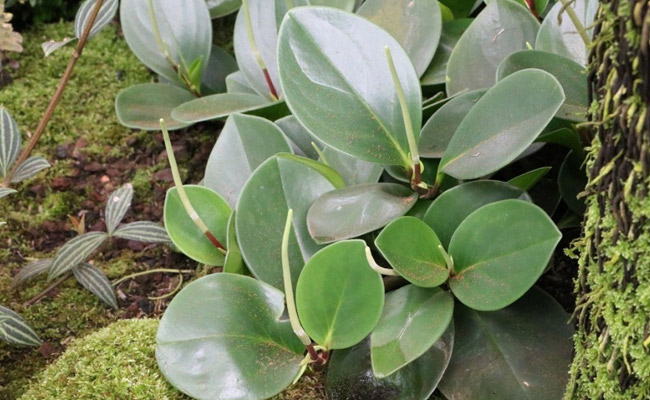
Peperomia Care
Beginner or professional, almost all peperomia types are a great addition to your houseplant collection. As mentioned earlier, these plants are convenient to care for as they handle a wide range of growing conditions perfectly.
They also serve as excellent decorative accents that are slow-growing, so you do not need to worry about re-potting your peperomia plant anytime soon. Here is what this plant needs to grow best:
Light Requirements
bright, indirect sunlight guarantees a happy shining bush plant. Therefore, we recommend placing it near an east- or west-facing windowsill at most times of the year. During the summer months, watch your solid or variegated peperomia leaves closely from time to time to make sure that they are not scorching due to excessive direct sunlight.
When placed in a spot with insufficient light, your plant will become leggy while stretching towards the available light. If this happens, prune the peperomia plant back to retain its compact shape (see below for pruning instructions), and move it to a better location. Fewer leaves, leaf drops, and coloration are other signs of insufficient light.
Note: While finding the ideal location, bear in mind that these tropical plants cannot tolerate temperatures less than 30 degrees Fahrenheit. In fact, they turn to mush outdoors in freezing temperatures. In case you are interested in growing radiator plants outdoors, they are perfect for mild climates with warm temperatures and high humidity.
Peperomia Watering
In peperomia care, you should water the plant thoroughly once the top one or two inches of the soil is dried out completely. Peperomia watering is crucial for the plant’s health while growing indoors. So be careful not to overwater it.
If you noticed any rotting stalks, wilting or yellowing leaves, waterlogged soil, and heavy container, you are watering your plant more than it needs. Irrigating every 7 to 10 days is probably good. But, to void these unfortunate signs, always check the dryness of the soil.
In the winter, you can significantly reduce the amount the water sessions. Some even do not water it completely during the winter months.
Humidity
Some peperomia care guides state that these plants require high humidity levels. However, it highly depends on the specific variety.
Many peperomia types have succulent-like characteristics, which enables them to tolerate low humidity levels and infrequent watering. This is another feature that turns this family perfect for growing indoors, as many indoor houseplants require relatively low humidity levels.
Since the humidity needs vary depending on the variety, for the best peperomia plant care, check the leaves. The thicker and more succulent they are, the lower humidity levels the plant will tolerate.
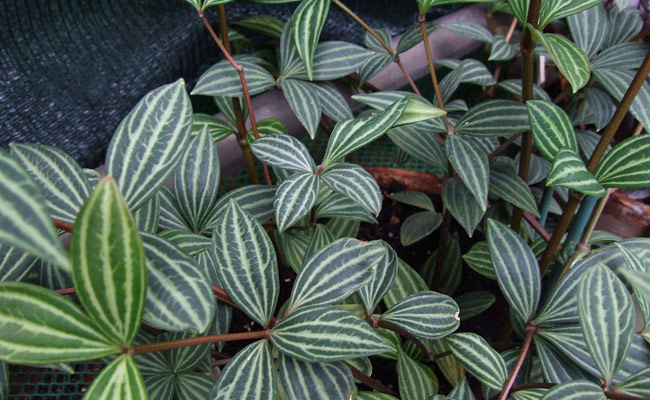
Peperomia Soil
In the wild, peperomia green and other varieties either grow in acidic, moist, well-drained soil or grow as epiphytes. Meaning they settle into a tree nook and send their roots into slightly decaying barks. To have a healthy plant, you need a potting mix with the same characteristics.
Regular well-draining potting soils work fine in peperomia care. Since overwatering can happen easily, remember that you can always add a handful of peat moss or vermiculite to the soil.
Tip: If you want to prepare the soil yourself, mix an equal amount of peat moss and perlite or coarse sand.
Fertilizer
Your green or variegated peperomia is more than forgiving if you feed it too little, it actually welcomes it. These species have very light fertilizing requirements. As you saw drab or dropping leaves are often a sign of overwatering or improper lighting and not lack of nutrition in its potting medium.
Although you can discard feeding in peperomia care completely, you may want to use a balanced 10-10-10 water-soluble fertilizer this slow-growing epiphyte during the growing season (summer months) once a month.
Pruning Peperomia Plant
When it comes to pruning radiator plants, do not hold back! Since they tolerate pruning really well, you can prune it with peace of mind in early spring for both cosmetic purposes and to encourage better growth by removing dead, damaged, or sparse growth.
To have a vibrant peperomia plant, it is best to detect unhealthy foliage, remove it quickly, and prevent it from recurrence. For more branches and a bushier appearance, remove the end of each stem and the first set of leaves using your hands or hand pruners.
Potting and Re-potting
Peperomia marble or any other variety typically does better in containers that are a little small. So, you can wait a little longer before transplanting it into a new pot. After 2 or 3 years, repot your plant in a similar-sized pot or one a little bigger and refresh its potting soil too.
For repotting, start with filling half of the new pot with proper soil. Continue by gently removing the from its old pot and carefully separating as much soil from the roots as possible.
Then, transfer the plant into the new pot and add the rest of the potting mix around the peperomia plant. Press the potting mix gently and finish by watering the plant thoroughly.
Encouraging the Blooms
Although peperomia’s spike flowers are not its true highlight, they occasionally show themselves even when you grow it as a houseplant. The unscented blooms have a brown or greenish-white color and naturally appear in summer.
However, if you manage to simulate summer’s lighting and temperatures in peperomia care indoors, it can bloom anytime indoors. You can cut them at the base or leave them to fall off as the flower withers.

Propagating Peperomia Plants
There are two methods to propagate radiator plants: You can use stem cuttings or choose peperomia propagation from leaf cuttings. There are two ways to decide on the best method:
- Your preference
- Plant’s species
Simply keep in mind that variegated peperomias are better propagated using stem cutting to maintain the leaf variegation.
Here are the instructions for both methods:
Propagating Peperomia Using Leaf Cutting
Before starting, prepare a propagation tray or a pot, an equal mix of potting compost and perlite. Also, sterile all equipment you use to prevent fungal disease in the future. Then:
- Using sharp scissors or pruning shears, cut a healthy leaf off the stem’s base or with a little stem attached. You can use whole leaves for propagation but cutting the leaf in two across its width is preferred.
- Dip the cut edges into rooting powder to encourage new roots to grow (optional).
- Make a small channel in the potting mix and insert the leaf-cutting 0.5 to 1 inch into the potting media. Firm the potting soil around the cutting and water thoroughly.
- Now you need to cover the peperomia plant’s cutting(s). If you are not using a covered propagation tray, cover the top of the plant pot with transparent plastic.
- Place the container in bright indirect light at room temperature. Every few days, remove the cover for a couple of hours to prevent excess humidity, which also can result in fungal disease.
- Water consistently and keep the soil moist during this time. After a few weeks, you will notice the development of new roots from the cut edge, then new shoot, and eventually new leaves.
Once your young peperomia green or variegated have several new sets of leaves, you can move the cuttings into individual pots. However, there is no need to hurry as this species has shallow root structures.
Propagating Peperomia Using Stem Cuttings
The ideal time for peperomia propagation by stem cuttings is in spring, and you will need the same equipment as the first method. After preparing them, follow these instructions:
- Cut a healthy stem off the plant with a clean pair of sharp scissors or pruning shears. It is better if the stem has at least three pairs of leaves on it.
- Remove the bottom pair of leaves. Now there is a short, exposed section of stem that can be planted easily.
- Dip cut end into rooting powder (optional) and insert it in a small hole in the potting mix. firm the potting mix around the cutting and water thoroughly.
- Cover the cuttings and place them in bright indirect light at room temperature. Remove the cover every few days to prevent excess humidity.
- Do not forget to water consistently and keep the soil moist during this time. Roots will develop in a few weeks and then you can transplant them into individual containers.
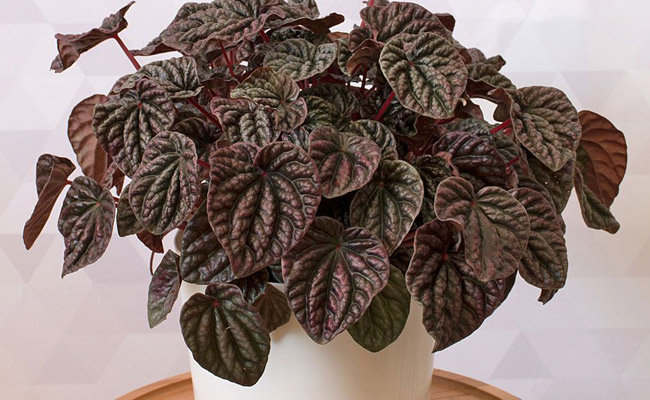
Peperomia Plants Common Problems
This species does not ask too much to grow slowly, yet happily. Although, some signs call for extra attention in peperomia plant care.
Why Is My Peperomia Plant Drooping?
Drooping leaves indicate underwatering, low humidity, extreme temperatures, pest infestation, or root rot caused by overwatering. If you also feel a rotting smell, the problem is definitely root rot.
If fungal disease is the case, to bring things back to normal (if it is not too late of course), pull out the plant from the pot, and remove any rotting, mushy roots that have turned black or brown. Wash the remaining healthy roots and let them dry for a few hours.
In the meantime, sterilize the pot in a diluted bleach solution. Finally, re-pot it in the clean pot with fresh soil.
Why Are the Leaves Curling or Yellowing?
peperomia leaves turn yellow or start curling when the plant receives more water than it needs. To remedy this problem, remove the yellowed leaves and adjust the watering.
And to prevent this problem in the future, in addition to correct irrigation, you may add a layer of pebbles to the bottom of the pot to improve drainage.
Why Is My Peperomia Plant Wilting?
Both underwatering and overwatering can cause this problem for peperomia varieties.
If underwatering is the reason, you can see that the plant has wrinkled, dry, wilting leaves, and or tips to the leaves. The soil is also dry right to the bottom. To solve this problem, simply water the plant properly and check the soil moisture levels.
If overwatering is responsible, the situation is more serious as it can lead to roots rotting and dying. If you feel the soil, you will instantly realize that overwatering is the problem. In this case, you need to react quickly to save your plant.
If the problem is not too severe, stop watering, let the soil dry out, remove any foliage that is damaged, and ensure to irrigate sparingly from this point. However, if your peperomia plant is wilting too much, you need to re-pot it.
For doing this, first, remove all damaged foliage. Continue by carefully removing the plant from the pot and gently separating as much of the waterlogged soil from the roots as you can. When the roots are exposed, remove the diseased roots with a sterile pair of scissors.
When only healthy roots remain, repot the plant in fresh potting mix with equal amounts of potting compost and perlite. After transplanting, water very lightly and wait for at least a week before watering again. From this point, only water after checking the soil. Hopefully, your plant survives this.
Why Are the Leaves Deformed or Dropping?
Ring spot is caused by the cucumber mosaic virus, and you can identify it by deformed leaves. Overwatering is usually the main reason for this disease. To treat your peperomia plant, simply remove the deformed leaves and water only when the potting soil is dry.
Dropping leaves are also a sign of overwatering. If you water your plant properly, try moving it to a spot with brighter light and not direct sun. But near a window with direct light is fine.
Why Is My Peperomia Plant Turning Brown?
Leaves that are turning brown indicate too little light. Too much direct sunlight causes sunburn and turns the peperomia leaves brown as well. You may want to find a better location for your green friend.
Why Is the Pooting Soil Moldy?
As you can guess, the cause of appearing whitish mold on the surface of the soil is nothing else than excess watering. To treat this, you need to modify your peperomia plant care a little bit. First, remove the top layer of soil and replace it.
If the goes deeper, wash the pot, and replace the soil entirely with a sterile mix. To stop it from reoccurring in the future, do not water before the soil is dried out.
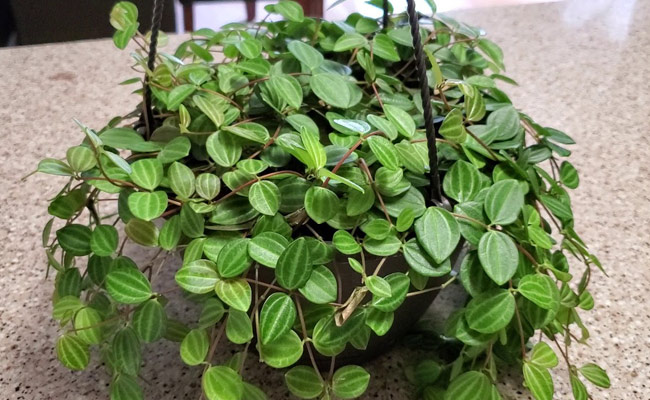
Radiator Plants Pests
Peperomia is fairly resilient to pests, but they can be subject to common pests that can affect most houseplants including:
- Fungus gnats: little black flies that can be found in the soil and deal damage by their larvae.
- Mealybugs: that show themselves as white spots on the lower surfaces of the leaves and on the roots, sometimes along the mealybugs, stopping the peperomia green from growing.
- And spider mites: which remain undetected for a long time. These pests cause dying areas on the leaves and prevent new growth.
In all three cases, you can use insecticidal soap for treating these pests conveniently.
Final Thoughts
Peperomia varieties are so beautiful and different from one another that you can have a complete collection of them, sometimes even forgetting that they are related.
This evergreen family exhibits attractive foliage, requires minimum maintenance, grows slowly, has compact sizes, and creates charming views without depending on flowers that perish in a matter of days or weeks. Features that only a couple of them turn every plant into a great addition to every space.
- In this post:
- Peperomia Plant Info
- Peperomia Types
- Peperomia Care
- Propagating Peperomia Plants
- Peperomia Plants Common Problems
- Radiator Plants Pests



